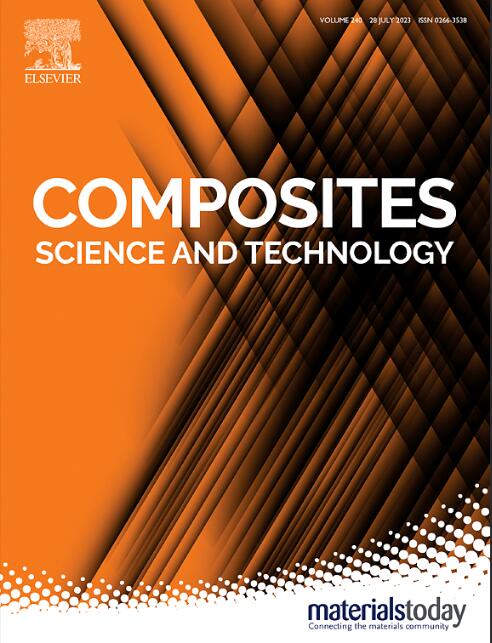多相纳米复合材料宽带反射损耗的综合实验与计算方法分析与设计
IF 9.8
1区 材料科学
Q1 MATERIALS SCIENCE, COMPOSITES
引用次数: 0
摘要
本研究提出了一种集成的实验和计算方法,用于分析具有陶瓷(BaTiO3, CoFe2O4)夹杂物和碳基夹杂物(MWCNTs)的多相复合材料,旨在宽带电磁(EM)反射损耗(RL)应用。表征技术(SEM, TGA和x射线三维断层扫描)被用来分析纳米复合材料。采用双端口VNA对制备的纳米复合材料进行了测试,并使用Nicolson-Ross-Weir (NRW)算法推导了复合材料的电磁性能。内部优化工具用于提取单个纳米颗粒的EM特性,然后使用实验结果验证它们。使用基于内部传输矩阵法(TMM)的工具获得频率范围内的RL频谱,并使用从双端口VNA获得的散射参数进行验证。随后,通过改变影响参数,使用经过验证的内部工具进行参数研究。结果表明,高BaTiO3或MWCNT含量的复合材料表现出阻抗不匹配,导致与纳米复合材料表面相互作用时立即产生EM反射。相比之下,cofe2o4为主的复合材料实现了宽带RL (<;-10 dB)在4.4 GHz的带宽上跨越不同的厚度,即使在更高的负载下,由于改进的阻抗匹配。入射横磁(TM)极化电磁波提供高达80°入射的宽带RL。相反,由于不同的场相互作用,横向电(TE)极化电磁波在40°角处显示出宽带RL。提出的广义方法为设计针对特定宽带或频率选择性RL应用量身定制的纳米复合材料提供了一个通用框架。本文章由计算机程序翻译,如有差异,请以英文原文为准。

Integrated experimental and computational approach to analyse and design multiphase nanocomposites for broadband reflection loss
This study presents an integrated experimental and computational methodology for analysing multiphase composites with ceramic (BaTiO, CoFeO) inclusions and carbon-based inclusions (MWCNTs) aimed at broadband electromagnetic (EM) reflection loss (RL) applications. Characterisation techniques (SEM, TGA, and X-ray 3-D tomography) were employed to analyse the nanocomposite. Fabricated nanocomposites were tested using a two-port VNA, and the EM properties of the composites were derived using the Nicolson-Ross-Weir (NRW) algorithm. An in-house optimisation tool is used to extract the EM properties of individual nanoparticles and later validate them using the experimental results. The RL spectrum in the frequency range is attained using the in-house Transfer Matrix Method (TMM)-based tool, which is validated using the scattering parameters obtained from the two-port VNA. Later, parametric studies are carried out using the validated in-house tools by varying the influencing parameters. Results have shown that composites with high BaTiO or MWCNT contents exhibited impedance mismatches, leading to immediate EM reflection upon interaction with the nanocomposite surface. In contrast, CoFeO-dominant composites achieved broadband RL ( -10 dB) over a bandwidth of 4.4 GHz across different thicknesses even at higher loading due to improved impedance matching. Incident transverse magnetic (TM) polarised EM waves provided broadband RL up to 80° incidence. In contrast, transverse electric (TE) polarised EM waves showed broadband RL at angles up to 40° due to different field interactions. The proposed generalised approach offers a versatile framework for designing nanocomposites tailored for specific broadband or frequency-selective RL applications.
求助全文
通过发布文献求助,成功后即可免费获取论文全文。
去求助
来源期刊

Composites Science and Technology
工程技术-材料科学:复合
CiteScore
16.20
自引率
9.90%
发文量
611
审稿时长
33 days
期刊介绍:
Composites Science and Technology publishes refereed original articles on the fundamental and applied science of engineering composites. The focus of this journal is on polymeric matrix composites with reinforcements/fillers ranging from nano- to macro-scale. CSTE encourages manuscripts reporting unique, innovative contributions to the physics, chemistry, materials science and applied mechanics aspects of advanced composites.
Besides traditional fiber reinforced composites, novel composites with significant potential for engineering applications are encouraged.
 求助内容:
求助内容: 应助结果提醒方式:
应助结果提醒方式:


